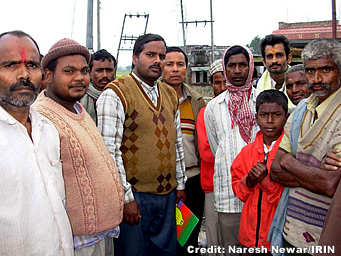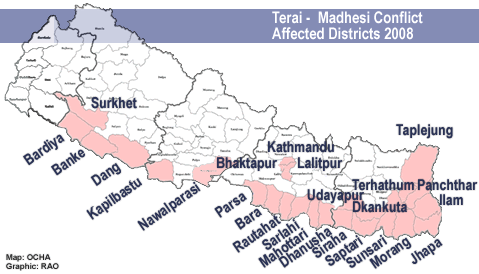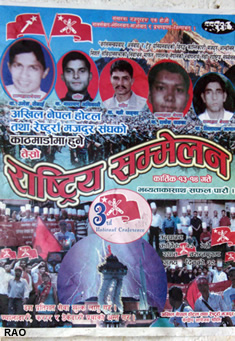|
Nepal
2008: Facts on the Conflict
|
|
New
Madhesi strike could have dire humanitarian impact
|
 |
KATHMANDU,
22 February 2008 (IRIN)
 |
| International
humanitarian aid agencies have expressed concern about the political crisis
and the humanitarian implications for vulnerable communities in the Terai
region of southern Nepal.
They
said access to food supplies, health and other humanitarian services has
been limited since 12 February due to an indefinite strike called by the
United Democratic Madhesi Front (UDMF) - a coalition of political parties
campaigning for the rights of ethnic Madhesis
in the Terai. |
|
"If
the crisis in the Terai goes on for another week, we will see a considerable
impact on humanitarian programmes in terms of food security, the livelihoods
of vulnerable communities and daily wage earners," Wendy Cue, head of the
UN Office for the Coordination of Humanitarian Affairs (OCHA) in Nepal,
told IRIN in Kathmandu.
Most
markets have been closed in cities and towns across the Terai, Nepal's
lowland industrial and agricultural heartland. The government-imposed curfew
is exacerbating the situation, hampering civilians' access to public transport
and markets, according to aid agencies.
Protests
by pro-Madhesi groups in the Terai have been exacerbating political tensions
also caused in part by the refusal of Maoist groups to abide by a November
2006 peace accord, according to analysts.
| "Possibility
of a humanitarian crisis" |
 |
| "There
is a possibility of a humanitarian crisis if there is no change in the
situation," said Sanjeev Kumar Kafley, director of the disaster management
department of the Nepal Red Cross Society (NRCS), which has been helping
to evacuate and provide medical aid to people injured in the Madhesi protests. |
|
He
said the humanitarian challenges were growing as marginalised and impoverished
civilians were being affected by the protests: "Many of the destitute and
daily wage earners are unable to find the jobs on which they depend for
survival," said Kafley.
Aid
workers targeted
A
group of leading agencies and international non-governmental organisations
(NGOs) said on 21 February that the operational room for manoeuvre was
shrinking. "At the moment, the operational space in the Terai has been
very much affected as development activities cannot be carried out," said
a donor representative who preferred anonymity.
"The
eastern Terai is especially looking very worrisome. All agencies are facing
difficulties," said Phillippe Clerc, country director of the Norwegian
Refugee Council (NRC), which is providing support to displaced people in
Nepal.
Aid
workers said the situation for them was becoming more challenging than
during the decade-long armed conflict (1996-2006).
Even
medical personnel and ambulances are being targeted and prevented from
freely moving around by both protestors and security forces in the Terai,
aid agencies said.
According
to the International Committee of the Red Cross (ICRC), an ambulance carrying
injured persons was vandalised in Mahottari District, some 130km south
of Kathmandu. Medical workers had been assaulted and their medical kits
seized.
However,
Madhesi leaders deny they have placed any obstacles in the way of humanitarian
work. Instead, they blamed government security forces for harassing aid
workers.
Madhesi
demands
The
UDMF has said it will continue the strikes and demonstrations against the
Nepalese government until its demands are met.
Most
Madhesis - the dominant ethnic group in the Terai - continue to suffer
from extreme poverty, high rates of illiteracy, unemployment and lack of
citizenship due to past neglect of their plight and their exclusion from
the development and political process.
The
current campaign is designed to address the perceived wrongs of the past
and improve the lives of the poor. Madhesi political groups have become
increasingly successful over the past year or so in drawing attention to
their plight, forcing political parties and the government to take note,
according to independent analysts.
The
UDMF has been demanding an autonomous region for the Madhesi people
Credit
IRIN 2008
Copyright
© UN Office for the Coordination of Humanitarian Affairs 2008
[
This report does not necessarily reflect the views of the United Nations]
Integrated
Regional Information Networks (IRIN), part of the UN Office for the Coordination
of Humanitarian Affairs (OCHA).

|
|
Refugees
in Nepal: Bacchu Rokaya and her children at an IDP camp in Rajhena of Nepalgunj
|
| Madhesi
factbox |
 |
 |
 |
 Nepal's
largest
ethnic group; make up about one third of Nepal's 27 million people Nepal's
largest
ethnic group; make up about one third of Nepal's 27 million people
 Concentrated
in the lowland Terai region, southern Nepal, the country's industrial and
agricultural heartland Concentrated
in the lowland Terai region, southern Nepal, the country's industrial and
agricultural heartland
 Traditionally,
their main ethnic rivals are the politically dominant hill people known
as Pahades Traditionally,
their main ethnic rivals are the politically dominant hill people known
as Pahades
 Comprised
of various sub-groups with several different languages and dialects and
have only recently developed a political consciousness and unity of purpose Comprised
of various sub-groups with several different languages and dialects and
have only recently developed a political consciousness and unity of purpose
 Campaign
for regional autonomy for the Terai, a federal Nepal, and greater representation
in parliament Campaign
for regional autonomy for the Terai, a federal Nepal, and greater representation
in parliament
 Militant
factions such as the Madhesi People's Rights Forum (MPRF) and the Janatantrik
Terai Mukti Morcha (JTMM) have carried out violent acts Militant
factions such as the Madhesi People's Rights Forum (MPRF) and the Janatantrik
Terai Mukti Morcha (JTMM) have carried out violent acts
 Not
allied in any way to the Maoists who have separate political goals Not
allied in any way to the Maoists who have separate political goals
 Include
some of the most impoverished and disadvantaged castes in Nepal such as
Badis (traditional sex workers) and Kamaiyas (bonded labourers) Include
some of the most impoverished and disadvantaged castes in Nepal such as
Badis (traditional sex workers) and Kamaiyas (bonded labourers)
According
to rights activists, Maoist leaders are unable to control their supporters. |
|
 |
 |
 |
 |
 |
External Links |
| More
on Nepal's Nationalities |
 |
 |
 |
|
Nepal
People |
|







